| Ancient History - The Roman World |
| In Pictures: |
****Hyperlinked titles will take you to our copy on sale or prebuilt searches of copies on sale****
Titles to Look Out For:
[In Alphabetical Order. Date signifies earliest edition. Later editions covered by each listing]
1967 (and later editions). Britannia: A History of Roman Britain by Sheppard Frere
1973. The Coritani [Peoples of Roman Britain] by Malcolm Todd
1998. Mark Antony by Pat Southern
1981. Out of Etruria: Etruscan Influence North and South by Larissa Bonfante
1991. The Roman Inscriptions of Britain. Volume II, Fascicule 2. Instrumentum Domesticum (Household Goods or Wares) by R. G. Collingwood and R. P. Wright
1993. The Roman Inscriptions of Britain. Volume II, Fascicule 5. Instrumentum Domesticum (Household Goods or Wares) by R. G. Collingwood and R. P. Wright
1995. The Roman Inscriptions of Britain. Volume II, Fascicule 7. Instrumentum Domesticum: Graffiti on Samian Ware
1995. The Roman Theatre and Its Audience by Richard C. Beacham
1999. Tiberius: The Politician by Barbara Levick |
On Amazon: |
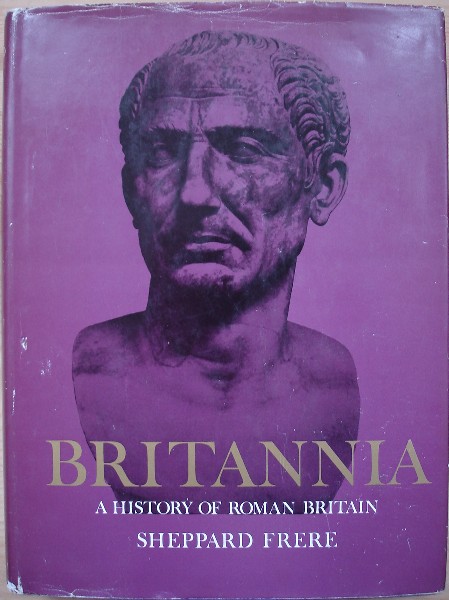
1974, BCA
Sorry, sold out, but click image above to access prebuilt search for this title on Amazon UK
Alternative online retailers to try:
Click here for our prebuilt search for this book on Abebooks
Click here for our prebuilt search for any edition of this title on Alibris |
- Britannia: A History of Roman Britain [top]
Written by Sheppard Frere
First published in 1967 in Great Britain in hardback by Routledge & Kegan Paul (no ISBN)
in Great Britain in hardback by Routledge & Kegan Paul (no ISBN)
Reprinted in 1967 and in 1969
Published on October 25, 1974 by Cardinal Books in paperback
by Cardinal Books in paperback
Reprinted in 1974 by Book Club Associates in hardback with dustjacket, 464pp, no ISBN
by Book Club Associates in hardback with dustjacket, 464pp, no ISBN
Revised edition published in July 1978 in Routledge & Kegan Paul
in hardback with dustjacket, 488pp, ISBN 0710089163
3rd revised edition published on August 8, 1991 in Great Britain by Pimlico in paperback, 432pp,
ISBN 071265027X
Published in 2000 and again in 2002
and again in 2002 by The Folio Society in hardback with slipcase
by The Folio Society in hardback with slipcase
About the book: This book is one of a series by various authors on the Provinces of the Roman Empire. Here the author has tried to present the history of Roman Britain using the available literary and epigraphical sources, and the results of archaeological research. He has not attempted to describe the archaeology of Roman Britain and in those chapters that deal with towns and countryside, rather than describe all available archaeological remains, he has confined his writings to a selective historical interpretation
Contents/Chapters:
List of plates
List of text-figures
Preface
Chapter 1. The background: the earliest British Iron Age
Chapter 2. Iron B and Iron C in Britain
Chapter 3. Caesar's expeditions
Chapter 4. Caesar to Claudius
Chapter 5. The Claudian Conquest: the rebellion of Boudicca and its aftermath
Chapter 6. The Flavian Period
Chapter 7. The retreat from Scotland: Hadrian's frontier
Chapter 8. The Antonine Wall and the frontier in the second century
Chapter 9. Severus and the third century
Chapter 10. The administration of Roman Britain
Chapter 11. The Roman Army in Britain
Chapter 12. The Towns
Chaper 13. The Countryside
Chapter 14. Trade and Industry
Chapter 15. The Romanisation of Britain
Chapter 16. Carausius and the fourth century
Chapter 17. The end of Roman Britain
List of abbreviations; Select Bibliography; Index
|
|
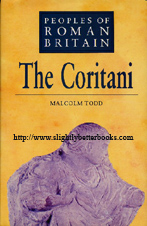
1991, Alan Sutton, hbk
Sorry, sold out, but click image above to access prebuilt search for this title on Amazon UK
Alternative online retailers to try:
Click here to access our prebuilt search for this title on Abebooks
Or click here to access our prebuilt search for this title on Alibris






|
- The Coritani [top]
Written by Malcolm Todd
First published in 1973 in Great Britain by Gerald Duckworth and Co. Ltd
in Great Britain by Gerald Duckworth and Co. Ltd
Revised edition published in 1991 in Great Britain by Alan Sutton Publishing Ltd, Phoenix Mill, Far Thrupp, Stroud, Gloucestershire, UK, in hardback with dustjacket, 164pp, ISBN 0862998786 . Original UK retail price of this edition: £14.95. Front cover shown to the left. Cover image: The Lincoln Charioteer. Includes 46 illustrations . Original UK retail price of this edition: £14.95. Front cover shown to the left. Cover image: The Lincoln Charioteer. Includes 46 illustrations
Revised edition published in 1991 in the United States by Alan Sutton Publishing Inc., Wolfeboro Fall, NH 03896-0848
About this book/synopsis: The Coritani were one of the largest tribes in Roman Britain. Their territory stretched from the Nene Valley to the Humber, and from the North Sea to the Hills of South Derbyshire. Within this large and varied landscape, the level of civic achievement varied from the squalor of the native villages in the valley of the Trent to the comparative splendour of the civitas capital at Leicester.
This is the 1991 Alan Sutton hardback reprint. This reissued volume has been extensively rewritten due to much new information being available on this part of Eastern Britain under Roman administration. Despite the new evidence, even in 1991 the principal themes of research from the early 1970s were still very much present in archaeology at the time of rewriting. Unfortunately the problem of non-publication of archaeological digs was also still present as a problem. This book therefore includes the most important advances in the archaeology of rural settlement, at least in terms of the accessible results
Malcolm Todd has excavated several Coritanian sites and published many papers on the archaeology of the region. At the time of publication (1991), he was Professor of Archaeology at Exeter University
Contents:
List of Illustrations; Preface
1. Tribal Territory and the Pre-Roman Iron Age
2. History: AD 43-367
3. Communications and Urban Settlement
4. Rural Settlement
5. Industry and the Economy
6. The Late Fourth and Fifth Centuries
Notes and References; Bibliography; Index
Illustrations:
1. Probable extent of the civitas Coritanorum
2. Major later Iron Age sites in the territory
3. Plan of the Iron Age settlement at Colsterworth (Lincolnshire)
4. Coastlines on the Northern shore of the Wash c. AD 200 (B.B. Simmons)
5. Early military occupation
6. Plan of large Claudian and later forts at Longthorpe (S.S. Frere)
7. Plan of Claudian and later forts at Great Casterton
8. Plan of large fort at Osmanthorpe (D.N. Riley)
9. Defences of minor towns
10. The network of communications
11. Sections across the Car Dyke and the Raw Dykes
12. The Car Dyke east of Helpingham (CUCAP)
13. General plan of Ratae Coritanorum
14. Plan of the forum of Ratae
15. Plan of the public baths of Ratae
16. Reconstruction of the baths (D.S. Neal)
17. The Blackfriars mosaic, Leicester
18. Central panel of the Peacock mosaic, Leicester
19. The topography of Lincoln (M.J. Jones)
20. The early colonia at Lincoln (M.J. Jones)
21. General plan of Margidunum
22. Topography and environs of Ancaster
23. Plan of minor town at Ancaster
24. Reconstruction of a part of the minor township at Sapperton (R.H. Healey)
25. General distribution of villas and minor towns
26. Plans of villas at Scampton, Thistleton and Winterton
27. Plans of stone round-houses at Bozeat and Winterton
28. Plans of aisled halls at Epperstone, Denton and Great Casterton
29. The villa at Cromwell and its environs (CUCAP)
30. Enclosures in the vicinity of the villa at Winterton (D.N.Rile)
31. The villa at Great Casterton
32. Enclosures and settlements at South Muskham (CUCAP)
33. Plan of settlement at Breaston
34. Settlement and enclosures at Lockington (CUCAP)
35. Roman farmstead at Willington (H.M. Wheeler)
36. Rural settlements noted in the text
37. Plans of rural shrines at Brigstock and Thistleton
38. Inscription recording the dedication of an arch to the god Viridios, from Ancaster (W.T. Jones)
39. Major sites of industrial working
40. Relief of a young charioteer from Lincoln
41. Bust of a youth (Britannicus?) found at Barwell
42. Pottery kilns at Swanpool and Boultham, south-west of Lincoln (M.J. Darling)
43. The late Roman tower at the South-West angle of the town at Ancaster
44. The bucket found at Mount Sorrell
45. The Jewry Wall, Leicester, and St. Nicholas' Church behind it
46. Early Anglo-Saxon cemeteries in the region |
|

1998, Tempus Publishing, hbk
Sorry, sold out, but click image above to access prebuilt search for this title on Amazon UK
Alternative online retailers to try:
Click here to access our prebuilt search for this title on Abebooks
Or click here to access our prebuilt search for this title on Alibris
|
- Mark Antony [top]
Written by Pat Southern
First published in 1998 in Great Britain by Tempus Publishing Limited in hardback with dustjacket, 160pp, ISBN 0752414062
About this book: Thanks to Shakespeare and the cinema, most people have heard of Mark Antony - but only in association with Cleopatra or Julius Caesar. He is therefore only known at second-hand, overshadowed by more successful Romans such as Augustus, who finally defeated him - and tried to obliterate his memory. Pat Southern redresses the balance with this long-overdue biography. She explores his career and unfolding character against the background of one of the most turbulent half-centuries in Rome's history. From an early age he appeared larger than life. His open, generous nature led him into undesirable company, he was notorious for his heavy drinking, his enormous debts and his womanising. But by the age of 28, he had established himself as a competent soldier and rapidly became one of Caesar's lieutenants. After Caesar's assassination, as Consul it was Antony who took control of Rome and skillfully avoided civil war and bloodshed. But he was outwitted by Octavian (Augustus) who became Consul by force and so formed the triumvirate with Lepidus as the sleeping partner. Although it was Antony who defeated Caesar's murderers at Philippi and although he married Octavian's sister, his actions in the East were resented in Rome. He was seen as an eastern potentate, besotted with Cleopatra. The two were defeated at the Battle of Actium; Alexandria was captured and at the age of 52 Antony committed suicide. Antony emerges as the most human of his contemporaries. Able as an administrator and a soldier, magnificent and magnanimous as a man, Antony was however his own worst - fallible and impetuous in his judgements and his attachements. His final self-destruction was perhaps inevitable
Contents:
Acknowledgements; List of Illustrations
1. A Mis-spent youth
2. Caesar
3. Civil War: Antony defeated
4. Civil War: Antony victorious
5. Eastern Promise
6. Parthia
7. Prelude to War
8. Decline and Fall
9. Posterity
Bibliography; Index |
|
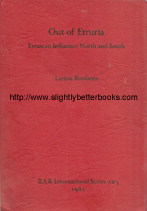
1981, BAR, pbk
In stock, click image above to buy for £45.50, not including post and packing, which is Amazon UK's standard charge (currently £2.80 for UK buyers, more for overseas customers)
Alternative online retailers to try:
Click here to access our prebuilt search for this title on Abebooks
Or click here to access our prebuilt search for this title on Alibris
Click here to access our prebuilt search for this title on Biblio


 |
About this book/synopsis: "Out of Etruria. Etruscan Influence North and South" is written by Larissa Bonfante and the contents of this book are:
Preface; Introduction
PART ONE. ETRUSCAN INFLUENCE IN THE NORTH: THE SITULA PEOPLE:
1. Etruscan Dress and Civilization in Northern Italy and Beyond
2. The World of the Situla People: A Proto-Urban Civilization
3. Situla People and Etruscan Art and the Aftermath in the North
4. Situla Art in Rome: The Corsini Throne
PART TWO. LANGUAGE AND ALPHABET:
5. Etruscan Influence in Early Rome; The Latin Word Triumphus
6. The Languages of the Situla People: Rhaetic, Venetic, Illyrian, Gallic by Giuliano Bonfante
7. The Spread of the Alphabet in Europe: Arezzo, Erz, and Runes by Giuliano Bonfante Bibliography; Maps; Illustrations.
About this book (from the introduction): The subject of this book is the influence of the historical people of the Etruscan cities, whose civilization came close to uniting Italy for the first time, and played an important role in the history of our own Western civilization. Such a study has been made possible, as well as desirable, by the extraordinary rate at which excavation and publication have been carried on in both Italy and Central Europe in the last 10 years. All this new material, and especially the more certain dates, are allowing scholars to sort out the identity of the various peoples in Italy, their relationships to each other, to the Greeks in Italy and across the sea and to the, and to the prehistoric peoples of Europe. The author states that they have tried to bring some of this information and bibliography together for an English-speaking public, for whom the specialized publications in which much of this dialogue occurs, are not easily available. The various chapters of this book all deal with specific contributions Etruscan civilization brought to Europe in the early period. Geographically, the area covered extends from Rome all the way to Scandinavia and the furthest limits of the northern runes. Thus the influence of Etruscan culture on Etruria's neighbours went well beyond the boundaries of Etruscan power, defined by Livy as extending from the Alps to the Straits of Messina.
The first section deals with Etruscan influence on situla art and the situla people in the north, where Etruscan culture early found its way. The area of situla art includes northeast Italy - the Veneto and the Po Valley, and the Alps and territory beyond, in modern Austria and Yugoslavia (shown on map 4).
The second part of the book deals with language and writing, and Etruscan influence, as well as its limits, to the north and south. Two words, one from Rome and one from the north, remain in our languages today to mark the extent of Etruscan influence in early Europe. The history of these two words, English: triumph (Latin: triumphus) and the German word Erz, is taken up in this section. Triumph stands for the proudest of Roman honours and the rite preserves Etruscan influence in Rome. The author traces the word's passage into Latin from the Etruscan word for dance, or tripudium.
The final two chapters are written by the author's father, Giuliano Bonfante and deal with the languages of the situla people; and with the alphabet, the chief benefit Etruscan civilisation brought to Europe. The Etruscans taught writing to the Latins, Ligurians, Gauls, Lepontians, Veneti, Rhaetians, Oscans and Umbrians (maps 9-10). As the first writing to come into the north, in the 6th Century BC, the Etruscan alphabet allowed the recording of these languages (Rhaetic, Venetic, Illyrian, Gallic) of Italy before Rome's unity established Latin as the dominant language.
Germanic runes were based on the Etruscan alphabet and found their way much further north. The coming of writing coincided with the introduction of the human figure in art; and it was the Etruscans who brought both. Giuliano Bonfante accounts for the early development of these Germanic and Scandinavian runes. In the 19th Century, Scandinavian runes were still being used in the northernmost areas of Europe, bearing witness to the earliest civilizing of Europe, long before that of the Greeks or Romans.
The book closes with the etymology of the German word "Erz", or "metal", which derives from the Etruscan city of Arezzo, famous for its bronze Chimaera and other important bronze statues. Northern peoples who imported bronze from Arezzo came to call it by the name of the city from where these sophisticated bronzes originated. Arezzo came to stand for "bronze" or "metal" in general |
|
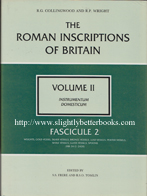
1991, Alan Sutton Publishing, hbk
3 copies in stock: £15, £15.25 and £15.50, all in very good condition (price doesn't include post and packing, which is Amazon UK's standard charge of £2.80)
Alternative online retailers to try:
Click here to access our prebuilt search for this title on Abebooks
Or click here to access our prebuilt search for this title on Alibris
Click here to access our prebuilt search for this title on Biblio



|
- The Roman Inscriptions of Britain, Volume II. Instrumentum Domesticum. Fascicule 2: Weights, Gold Vessel, Silver Vessels, Bronze Vessels, Lead Vessels, Pewter Vessels, Shale Vessels, Glass Vessels, Spoons (RIB 2412-2420) [top]
Compiled and written by R. G. Collingwood and R. P. Wright; edited by S. S. Frere and R. S. O. Tomlin
Published in 1991 in Great Britain for the Administrators of the Haverfield Bequest by Alan Sutton Publishing, in hardback with dustjacket, 152pp, ISBN 0862998204. Volume 2 includes RIB 2412 - 2420
About this book/synopsis: The Roman Inscriptions of Britain is the definitive publication of Roman written sources for the province of Britannia within the Roman Empire. The Roman Inscriptions of Britain series was published with the aim of covering ALL materials on which it is possible to inscribe or carve, so providing a comprehensive collection of primary source materials - primary written materials for Roman Britain. Volume I, published in 1965, dealt with inscriptions on stone. At that time, it was announced that the Instrumentum Domesticum (Minor Inscriptions) would be published as a second volume. However, work on the complex and varied body of material took longer than expected and, in 1986, it was decided that publication of volume ii should be facilitated by dividing it into Fascicules. This decision also allowd the original cut-off date for entries to be extended from 1956 to 1986, thus including the considerable quantity of new material from excavations and elsewhere.
Fully illustrated with drawings and diagrams and packed full of information and technical data, The Roman Inscriptions of Britain Volume II covers weights, a gold vessel, silver vessels, bronze vessels, lead vessels, pewter vessels, shale vessels, glass vessels and spoons.
The text gives transcriptions, translations, descriptions, bibliography and notes for each entry. It has been edited by Professor Frere, who has been able to draw on the written drafts of R. P. Wright, with critical advice being provided by R. S. O. Tomlin.
Contents
Preface By R. M. Harrison, Chairman of the Administrators of the Haverfield Bequest
List of Plates
Abbreviations
Bibliography
2412.1 - 122 Inscribed Steelyards, Scale-pans and Weights
2413.1 Gold Vessel
2414.1 - 39 Silver Vessels
2415.1 - 71 Bronze Vessels
2416.1 - 14
Lead Vessels
2417.1 - 43 Pewter Vessels
2418.1 - 3 Shale Vessels
2419.1 - 176 Glass Vessels
2420.1 - 63 Spoons
Index of Sites
List of Plates (at end of book, all black & white photographs)
I. A, B. The Carvoran modius (RIB 2415.56)
II. A. The Rudge Cup (RIB 2415.53)
-B. Bronze patera from South Shields (RIB 2415.55)
III. A. Silver trulla from Backworth (RIB 2414.36)
-B. Bronze trulla from Colchester (RIB 2415.48)
-C. Bronze trulla from Prickwillow, Isle of Ely (RIB 2415.11)
IV. A. Handle of a bronze trulla from Maften, Northumberland (RIB 2415.40)
-B. Handle of a bronze trulla from Matfen (RIB 2415.44)
-C. Handle of a bronze trulla from the river Witham (RIB 2415.35)
V. Handle of a bronze trulla from Lincolnshire (RIB 2415.41)
VI. A. Handle of a bronze trulla from Prestwick Carr (RIB 2415.32)
-B. Panel of a lead casket from East Stoke, Nottinghamshire (RIB 2416.8)
VII. A. Glass chariot - cup from Hartlip, Kent (RIB 2419.18)
-B. Glass bowl from Wint Hill, Avon (RIB 2419.45)
VIII. A. Silver spoon from unknown provenance (RIB 2420.61)
-B. Pewter bowl from Sutton, Isle of Ely (RIB 2417.29)
|
|
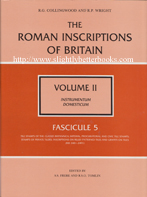
1993, Alan Sutton Publishing, hbk
7 new copies in stock at £15.00 each (price doesn't include post and packing, which is Amazon UK's standard charge of £2.80)
Alternative online retailers to try:
Click here to access our prebuilt search for this title on Abebooks
Or click here to access our prebuilt search for this title on Alibris
Click here to access our prebuilt search for this title on Biblio



|
About this book/synopsis: The Roman Inscriptions of Britain is the definitive publication of Roman written sources for the province of Britannia within the Roman Empire. The Roman Inscriptions of Britain series was published with the aim of covering ALL materials on which it is possible to inscribe or carve, so providing a comprehensive collection of primary source materials - primary written materials for Roman Britain. Volume I, published in 1965, dealt with inscriptions on stone. At that time, it was announced that the Instrumentum Domesticum (Minor Inscriptions) would be published as a second volume. However, work on the complex and varied body of material took longer than expected and, in 1986, it was decided that publication of volume ii should be facilitated by dividing it into Fascicules. This decision also allowd the original cut-off date for entries to be extended from 1956 to 1986, thus including the considerable quantity of new material from excavations and elsewhere.
In this fully illustrated hardback volume published in 1993 are covered the tile stamps of the Classis Britannica (literally the British Fleet, or rather the fleet of the Roman province of Britannia); imperial, procuratorial and civic tile stamps; stamps of private tilers; inscriptions on relief-patterned tiles and graffiti on tiles. The text gives transcriptions, descriptions (where and when found), bibliography and notes for each entry. It has been edited by Professor Frere, who has been able to draw on the written drafts of R. P. Wright, with critical advice being provided by R. S. O. Tomlin.
Contents:
Preface by Alan Bowman, Chairman of the Administrators of the Haverfield Bequest
List of Plates; Abbreviations; Bibliography
RIB 2481 Tile-Stamps of the Classis Britannica
RIB 2482-4 Imperial Tile-Stamps
RIB 2485 Procuratorial Tile-Stamps
RIB
2486-2488 Civic Tile-Stamps
Introduction
RIB
2487 Civic Tile-Stamps with Duoviri
RIB 2488 Civic Tile-Stamps with Quinquennales
RIB 2489 Stamps of Private Tile-makers
RIB 2490 Relief-patterned Tiles
RIB 2491 Graffiti on Tiles
Index of Sites
List of Plates (at end of book, all black & white photographs)
I. A. Tile-stamp of the Classis Britannica from Folkestone, Kent. RIB 2481.99.
-B. Tile-stamp of the Classis Britannica from Bodiam, East Sussex, RIB 2481.107 (iii)
-C. Civic tile-stamp from Gloucester RIB 2486.34 (i)
II. A. Civic tile-stamp from Gloucester RIB 2487.7 (i)
-B. Tile-stamp from Colchester, Essex RIB 2489.25
-C. Tile-stamp from Welton, Lincolnshire RIB 2489.12 (ii)
III. Tile-stamp from Silchester, Hampshire RIB 2489.18 (vii)
IV. A. Tile-stamp from Canterbury, Kent RIB 2849.35 (ii)
-B. Tile-graffito from Great Chesterford, Essex RIB 2491.125
V. A. Tile-graffito from Beauport Park, East Sussex RIB 2491.98
-B. Tile-graffito from York RIB 2491.160 (i)
VI. A. Tile-graffito from (?) the Lillyhorn Villa, Gloucestershire RIB 2491.209
-B. Tile-graffito from Witcombe, Gloucestershire RIB 2491.224
VII. A. Tile-graffito from Binchester, Durham RIB 2491.146 (i)
B. Tile-graffito from Cirencester, Gloucestershire RIB 2491.46
C. Tile-graffito from Godmanchester, Cambridgeshire RIB 2491.99
VIII. A. Tile-graffiti from Ewhurst, Surrey RIB 2491.178
B. Tile-graffito from Silchester, Hampshire RIB 2491.148
|
|

1995, Alan Sutton, hbk
In stock: very good condition copies available for £12.50 each
Alternative online retailers to try:
Click here to access our prebuilt search for this title on Abebooks
Click here to access our prebuilt search for this title on Alibris
Click here to access our prebuilt search for this title on Biblio |
Synopsis: Volume II, Fascicule 7 of the definitive "The Roman Inscriptions of Britain" series looks at graffiti on samian ware (terra sigillata) of which 879 examples had been found prior to this book being published. This large number, and the fact that samian sherds can usually be dated, provide a valuable statistical basis for the study of nomenclature, abbreviations, the growth of basic literacy and other epigraphic questions.
Like its predecessor, this fascicule has been compiled by Shepherd S. Frere from the archive collected by R. P. Wright and from other records of objects found down to the end of 1986. Critical assistance on readings and interpretations has been given by Dr. R. S. O. Tomlin, who has also provided a number of drawings of graffiti recorded by him in successive volumes of Britannia and elsewhere. M. W. C. Hassall has provided eighty-one drawing of graffiti similarly published and his transcriptions and commentaries in 'Britannia' have formed a primary source. Dating the graffiti themselves depends upon an estimate of the probable life-span of a vessel before breakage; in general this is hard to calculate with any pretence of accuracy, but normally it is unlikely to have been prolonged - at least in military environments
Contents:
Preface by Alan Bowman, Chairman of the Administrators; Abbreviations; Bibliography; 2501.1-880 Graffiti on Samian Ware; Index of Sites. The graffiti are arranged in seven groups:
(a) 2501.1.14: Military graffiti (and No. 617)
(b) 2501.15-21: Dedicatory or Descriptive graffiti
(c) 2501.22-637: Personal Names, certain, abbreviated or restorable
(d) 2501.638-836: Acephalous graffiti
(e) 2501.837-870: Numerals
(f) 2501.871-879: Addenda
(g) 2501.880: Falsum |
|
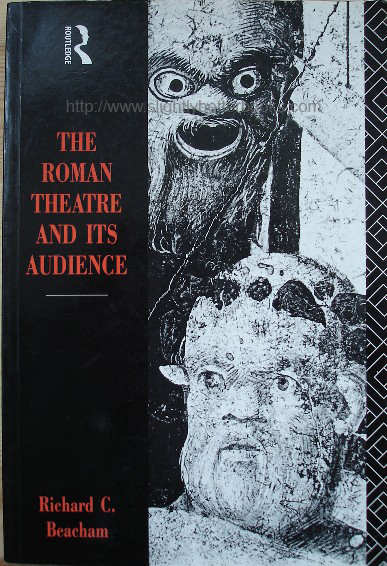
1995, Routledge
Sorry, sold out, but click image to access prebuilt search for this title on Amazon
Alternative online retailers to try:
Click here for our prebuilt search for this book on Abebooks
Click here for our prebuilt search for any edition of this title on Alibris



|
- The Roman Theatre and Its Audience by Richard C. Beacham [top]
Written by Richard C. Beacham
First published in 1991 in Great Britain by Routledge in hardback, 280pp, ISBN 041500067X
Published on July 20, 1992 in the United States by Harvard University Press in hardback, 276pp, ISBN 0674779134
Published in 1995 in Great Britain by Routledge in paperback, 267pp, ISBN 0415121639
Cover illustration: Detail of a Roman Wall Painting from the Villa of the Mysteries at Pompeii
Contents/synopsis:
Drawing on recent archaeological investigations, new scholarship and the author's own original research and staging experience, this study traces the history of the Roman theatre from its origins in the 4th Century BC to the demise of formal theatrical activity at the end of antiquity. Richard C. Beacham identifies the Roman theatre's most important characteristics and its legacy, placing particular emphasis on the way the audience influenced and reacted to performance. The book has been substantially updated for the paperback edition; aided by 35 b&w illustrations, a full bibliography and index, it provides an intriguing introduction for general readers and students, while presenting a great deals which will be of interest to the specialist. Cover illustration is of a Roman Wall Painting from the Villa of the Mysteries at Pompeii
Chapters:
List of illustrations
Preface
1. An Audience In Search of A Theatre
2. The Famous Comic Playwrights of Rome
3. Early Roman Stages
4. A Funny Thing: Performing a Play by Plautus
5. Tragedy, Mime and Pantomime
6. Later Stages and Stagings
Postlude: A Theatre in Search of An Audience
Notes; bibliography; audience
Illustrations:
Frontispiece: Mosaic depiction of street musicians
1. Phlyax vase showing Heracles in a farcical scene
2. Phlyax vase depicting actors playing Chiron and Achilles
3. Etruscan tomb painting representing performers
4. 'Room of the Masks' painting depicting a temporary stage
5. Representation of a stage set from the Villa of Oplontis
6. A stage facade and performers in a painting in the House of the Gladiators
7. Central section of a stage facade depicted in the 'Room of the Masks'
8. Architectural painting in the House of the Vettii
9. Painted architectural facade from the Villa of P. Fannius Sinistor
10. Depiction of a stage set in the House of Pinarius Cerialis
11. Reconstruction of a temporary paraskenia stage
12. Replica Roman temporary stage, University of Warwick
13. Scene from Plautus' Casina; Olimpio and Chalinus
14. Scene from Casina; Cleostrata and Chalinus
15. Scene from Casina; Lysidamus and Olimpio await their 'bride'.
16. Scene from Casina; Cleostrata and Lysidamus
17. Painting depicting a tragic actor
18. Relief representing a scene from tragedy
19. Remains of a Roman theatre at Sabratha
20. Detail of a painting at the Villa of Oplontis showing scenic panels and drapes
21. Replica temporary stage showing scenae ductiles and siparia
22. Detail of Warwick University replica Roman set
23. Relief painting depicting a scene from comedy
24. Painting from the Villa of P. Fannius Sinistor thought to depict comic scenery
25. Painting from the House of Casca Longus, showing a comic scene
26. Mosaic depiction of a tragic mask
27. Ivory statuette of a tragic actor
28. Depiction of the Roman theatre at Miletus
29. Illumination from a late medieval manuscript depicting a performance of Terence
30. Woodcut illustration from the Terence edition of 1493
31. Illustration depicting a Roman theatre from the 1521 edition of Vitruvius' 'On Architecture: Bks. I-X ' '
32. General view of the Teatro Olimpico
33. The scenae frons of the Teatro Olimpico
34. General view of the Teatro Farnese, Parma
About the Author: At the time of publication, Richard C. Beacham was Professor of Theatre History at the University of Warwick and has written extensively on theatre history. He has also translated Roman dramas and presented these before contemporary audiences |
|
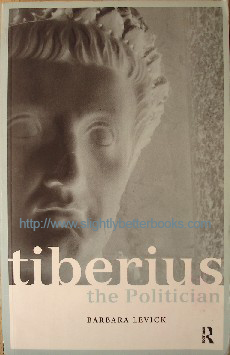
1999, Routledge, pbk
Sorry, sold out, but click image above to access prebuilt search for this title on Amazon UK
Alternative online retailers to try:
Click here for our prebuilt search for this book on Abebooks
Click here for our prebuilt search for any edition of this title on Alibris

|
- Tiberius: The Politician [top]
Written by Barbara Levick; New preface and supplementary Bibliography by Barbara Levick in 1999
Cover design - Tiberius AD14-37
First published on August 31, 1976 by Thames and Hudson Ltd in hardback, 328pp, ISBN 0500400296
Reprinted in 1986 by Croom Helm Ltd
Reprinted in a new revised edition in 1999 in Great Britain by Routledge in paperback, 328pp, ISBN 0415217539. Original UK retail price: £14.99
About this book/synopsis: The book examines Tiberius's life - was he really a morose and self-indulgent recluse, governing the empire through the instruments of corrupt favourites? Or did his gloomy nature simply reflect the essence of the role of the Emperor of Rome?
This book looks comprehensively at Tiberius's life and times -ancestry and education, provincial and foreign policy and at his senior years, when he gained some notoriety...
Chapters:
1. Ancestry and Education
2. First Years in Politics: Tiberius in the Service of the Princeps
3. Eminence and Eclipse
4. Rehabilitiation: The Final Struggle for the Succession
5. The 'Accession' of Tiberius
6. The Policy of the Princeps
7. Policy in Practice: The Senate and its Members
8. Equites and Plebs
9. Provincial and Foreign Policy
10. The Dynastic Catastrophe
11. Tiberius and the Law
12. Last Years and Posthumous Reputation
List of Abbreviations; Notes; Select Bibliography
Maps:
1. Italy in the time of Tiberius
2. The Eastern Roman Empire
3. The Western Roman Empire
Stemmata:
A. The Connexions of Tiberius
B. The Family of Augustus
C. The Descendants of Scribonia
D. Stemma of Sejanus (Conjectural); Index
About the author:
At the time of publication, the author had been a Fellow and Tutor in Literae Humaniores at St. Hilda's College, Oxford. She has also authored Claudius (1990) and Vespasian (1999) |
|










